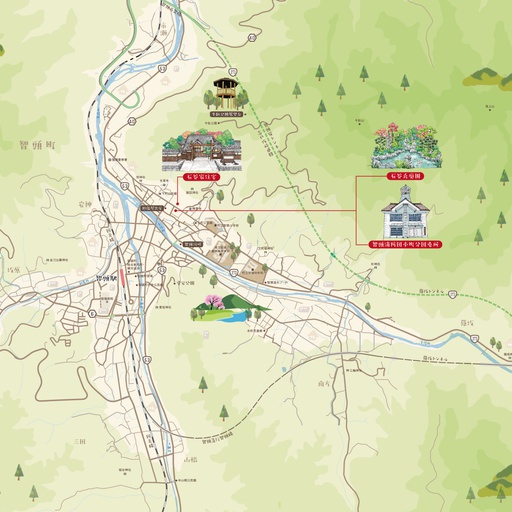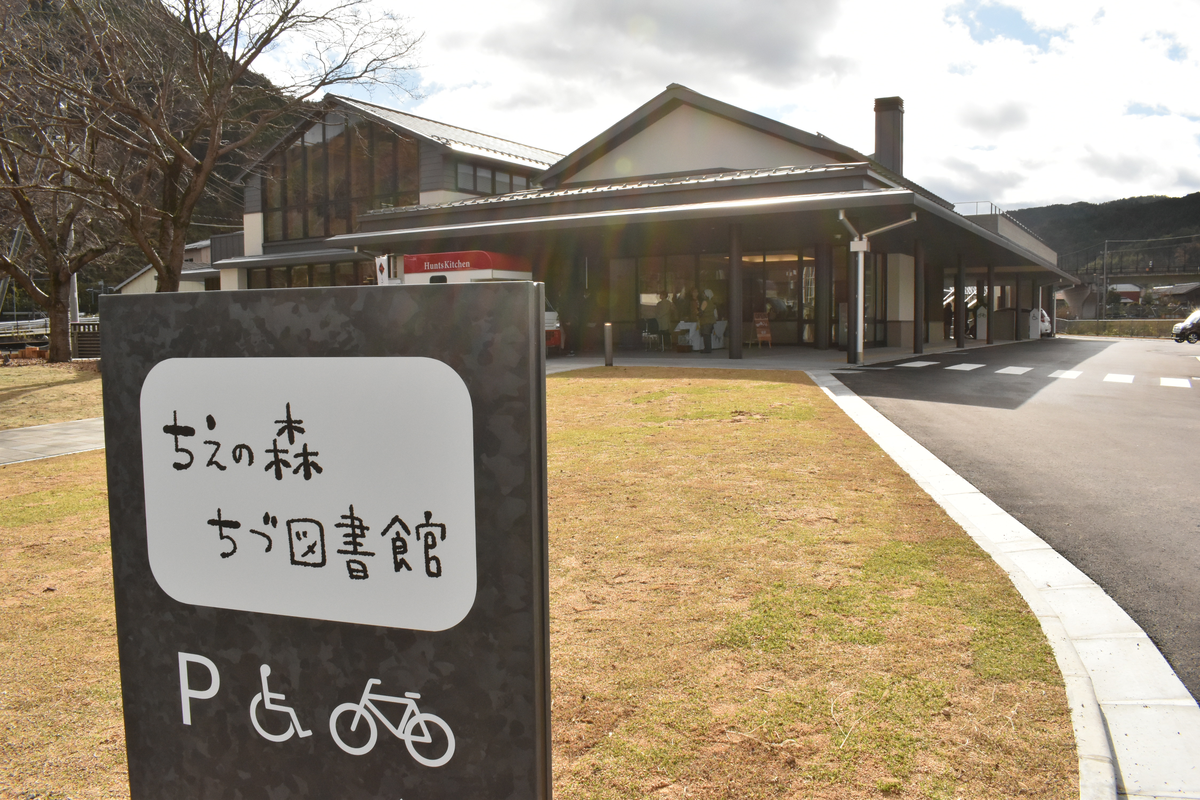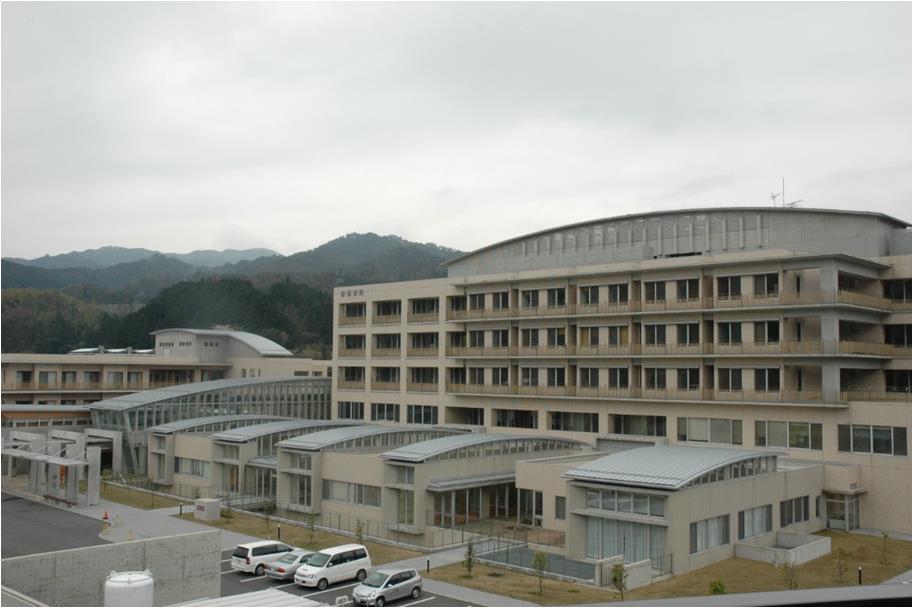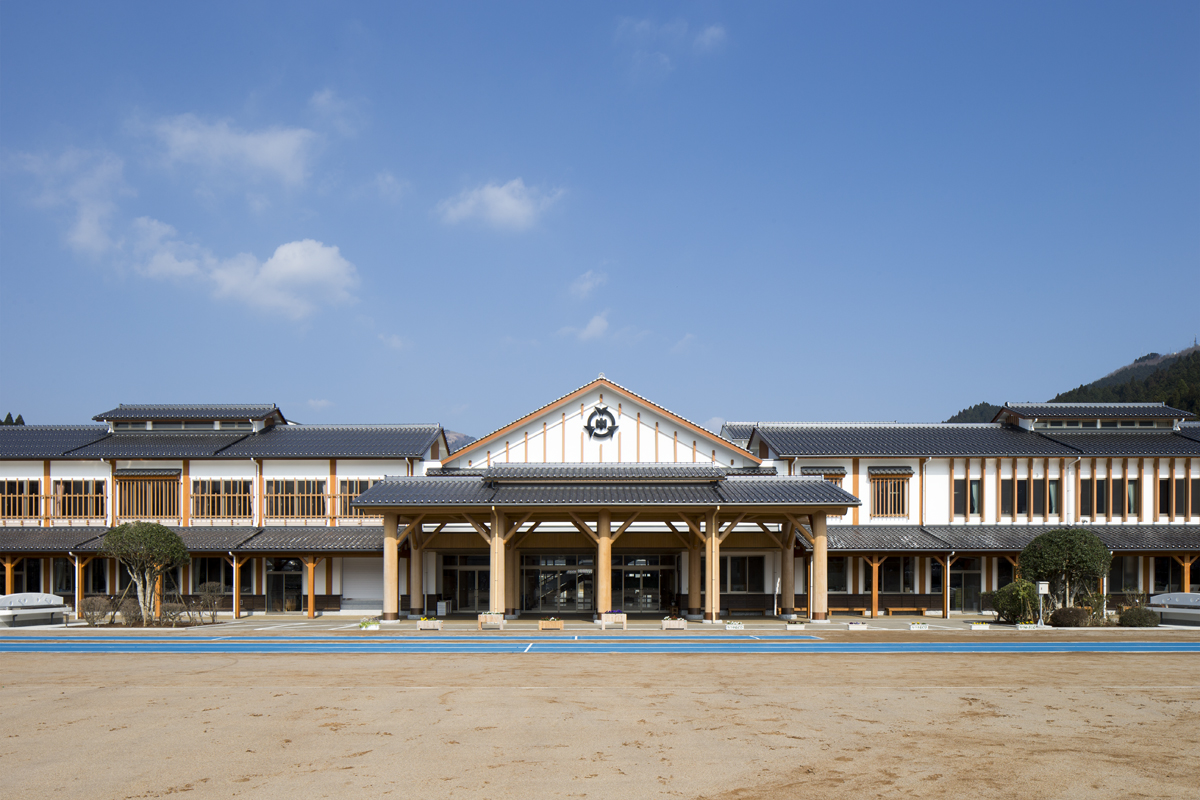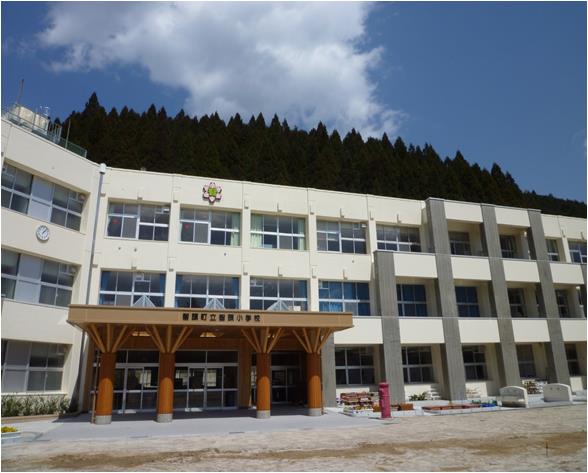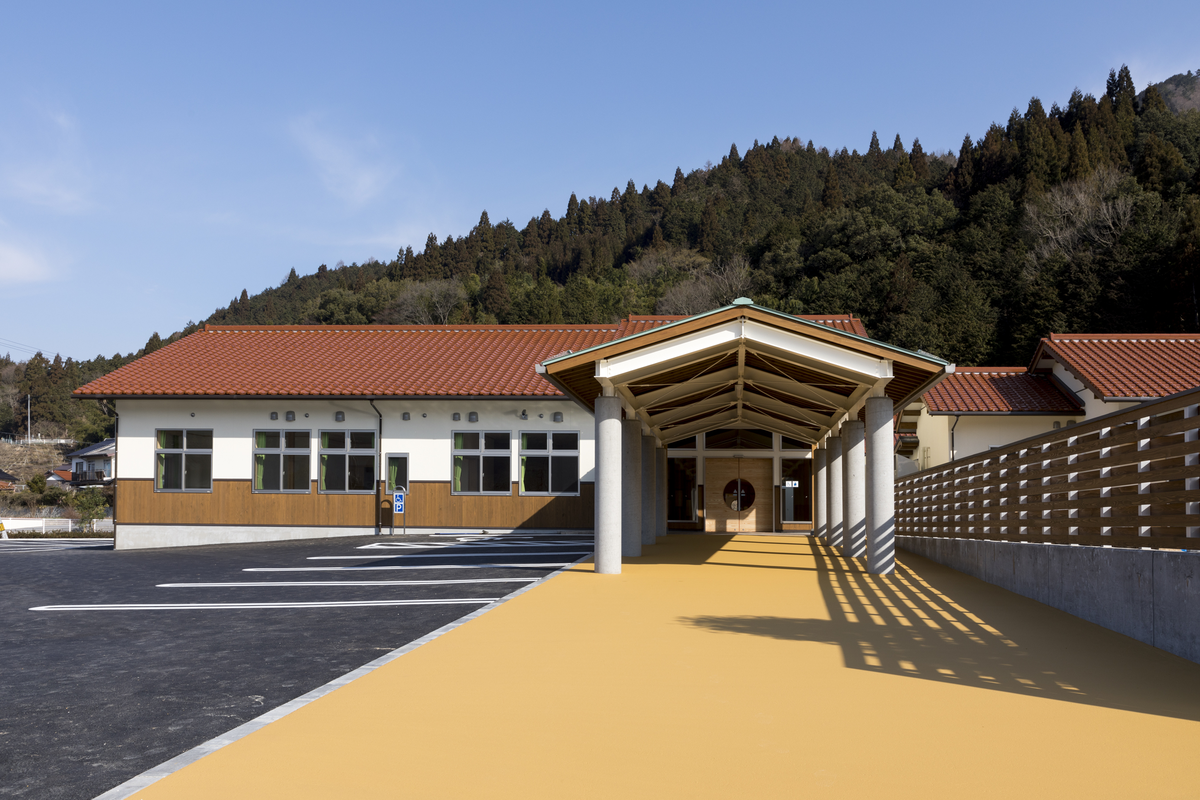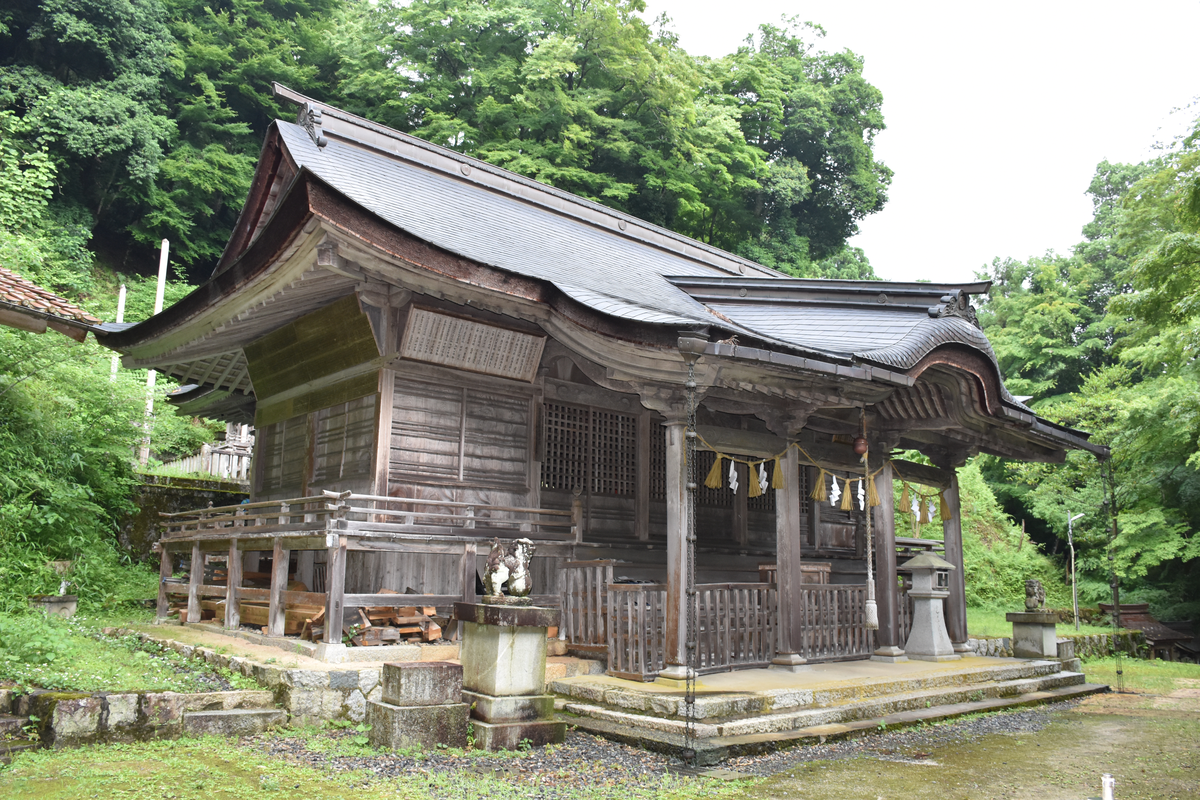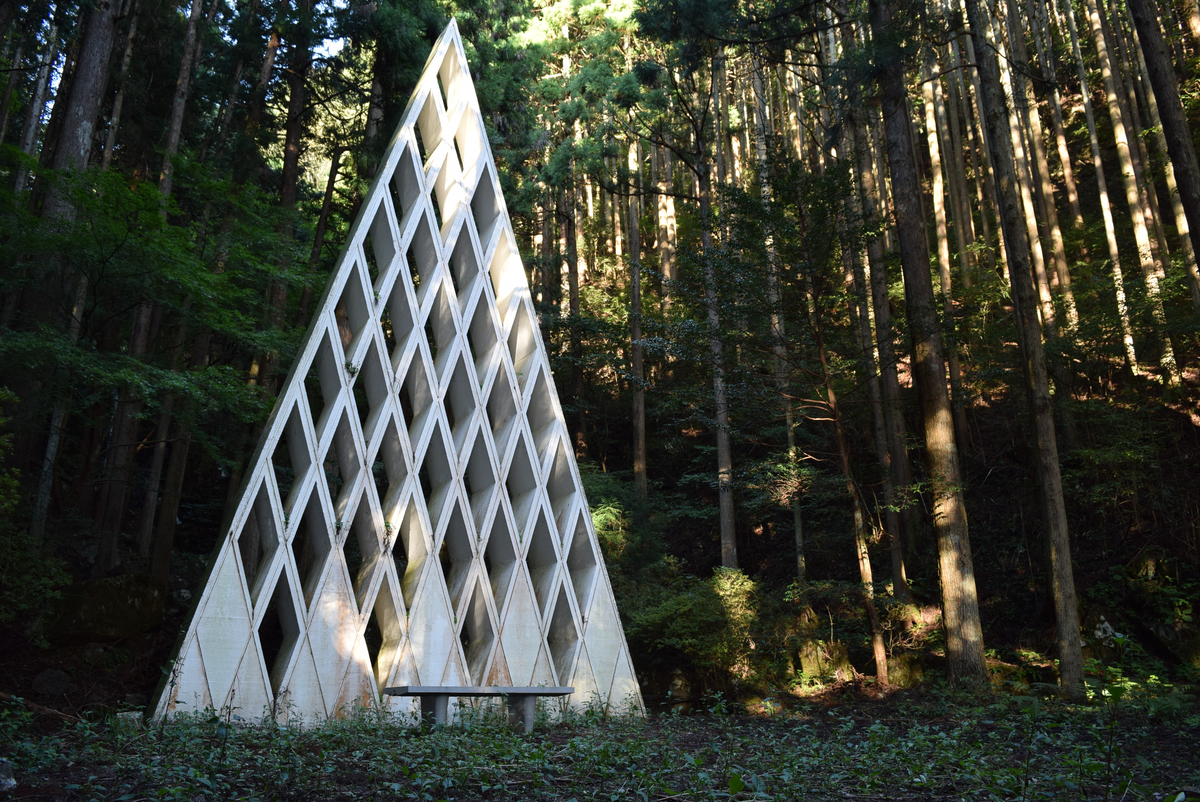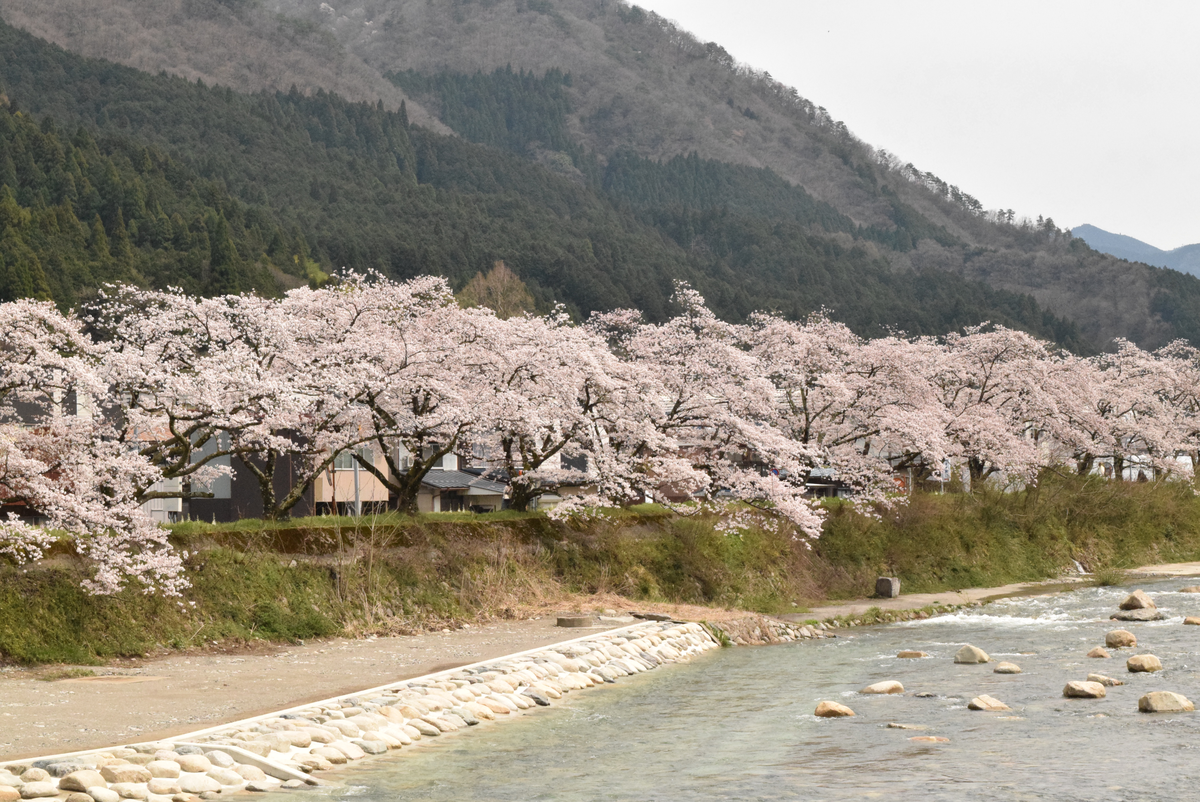All spots information
16 spots
 文化財スポット(multilingual)
文化財スポット(multilingual)
智頭消防団本町分団屯所
![]() 文化財スポット(multilingual)
文化財スポット(multilingual)

日本語 English 简体中文 繁體中文 智頭消防団本町分団屯所 国登録有形文化財(建造物) 登録:2000年12月20日 智頭街道に面して建つこの消防屯所は、高台に位置するため視界が大きく開け、智頭町が一望できる。何度か改修を重ねながら今も現役で利用されている。建物は木造総2階建、平入。建築面積80㎡。瓦葺、外壁は下見板張りのペンキ仕上げで洋風である。正面の屋根中央部を切妻破風(はふ)に切り上げ、大きく張り出して建物の正面を演出している。その上部に切妻造の火の見櫓(やぐら)をのせる。火の見櫓は、鉄板葺、外壁は吹き放し(腰壁は下見板張り)、1階外部から直接登ることができる。正面中央壁に沿った梯子段が架けられ切妻破風を貫通して櫓にいたる独特の構成。櫓には1942年銘のある半鐘が吊り下げられている。現在では数少ない昭和時代(1926~1989年)初期の消防屯所建築の遺構として貴重で、因幡街道宿場町の面影を残す智頭街道の景観に貢献している。独特の外観から地域のランドマークとしても親しまれている。 住所 鳥取県八頭郡智頭町大字智頭568、569 電話番号 - - Chizu Fire Brigade Honmachi Branch Station Nationally Registered Tangible Cultural Property (Structure) Designated on: December 20, 2000 The 1st Firefighting Group was established at Chizu Post Station in the early Taisho period (1912-1926). This was followed by firefighting groups being established in each of the surrounding villages, with the eighth and final group forming in 1932. In 1934, the Tottori Shinpo newspaper reported the activities of a women's firefighting troop in the Yamagata district, showing that these firefighting groups were very active in the Chizu area. As the wartime atmosphere deepened after the Second Sino-Japanese War began in 1937, Chizu Town's Firefighting Groups expanded their facilities and operations, setting up firefighting stations. Their efforts were commended by the Minister of Internal Affairs, and in 1939, the Firefighter Groups were reorganized to form the Chizu Town Civil Defense Unit. The Chizu Town Civil Defense Unit was selected as one of 20 outstanding organizations nationwide in 1941; and presented with an award flag by the Minister of Internal Affairs. This prompted Kanmachi's Civil Defense Unit 1st Division to build a station the same year. This is now the current "Chizu Fire Brigade Hommachi Branch Station." Located on the Chizu Kaido Road, the station stands on high ground commanding a wonderful view of Chizu Town. The building has been repaired several times; but is still in use. The station is a two-story wooden building in the Hirairi style, with the front entrance facing the road. The floor area is 80 m2, and the pantile roofs and exterior walls covered with painted clapboard siding lend the building a Western air. The center part of the roof in the front is gabled, with a large overhang that emphasizes the front-facing aspect of the building. Like other pre-war firefighting facilities, the building is fitted with a gable-roof fire lookout tower. The fire lookout has a steel tiled roof, with clapboard siding. A ladder runs up the center of the exterior front wall, allowing the firefighters to climb up into the lookout directly from the ground outside the building. Hanging in the lookout belfry is a bell with the inscription "1942 ". The ladder and bell form unique features of the stations design.Few fire station buildings from the pre-war period remain today, making the Chizu Fire Brigade Honmachi Branch Station an invaluable cultural, historic and architectural asset. The building’s unique shape also makes the station a familiar local landmark, and the iconic design adds to the atmosphere of this historic Inaba Kaido Road post town. Address 568, 569, Chizu, Chizu Town, Tottori Prefecture Phone number - - 智头消防团本町分团驻地 国家登记物质文化遗产(建筑物)登记日期:2000年12月20日 面向智头街道所建的消防驻地位于高地,因此视野开阔,整个智头町的景色可以一览无遗。虽然经过多次翻修,但如今仍在使用中。建筑物为木造结构,共有2层,平入式。建筑面积为80㎡。屋顶采用栈瓦铺设,外墙镶满涂漆的雨淋板,充满了西式风格。正面的屋顶中央部分为切妻破风,大幅度地向外伸展,为建筑物的正面增色添姿。其上部是切妻造(悬山顶式)的火警瞭望台。火警瞭望台采用铁板铺设屋顶,外墙贯通(高度至腰部的矮墙是雨淋板),从1楼外侧可以直接爬上去。沿着正面中间墙壁架设的楼梯贯穿切妻破风后通往瞭望台,结构非常独特。在瞭望台上悬挂着有1942年铭文的梵钟。作为当今时代为数不多的昭和时代(1926~1989年)初期消防驻地建筑遗迹,这处消防驻地非常珍贵,对因幡街道宿场町的景观做出了贡献。独特的外观也使其成为了广受欢迎的区域地标。 地址 鳥取県八頭郡智頭町大字智頭568、569 电话番号 - - 智頭消防團本町分團屯所 國家登錄有形文化遺產(建築物)登録日期:2000年12月20日 面對智頭街道的這個消防駐在所因位於高台,視野遼闊,可一望智頭町。雖經過了幾次的改建,現在也仍被使用著。建築物為木造共2層樓建築,平入構造。建築面積80㎡。棧瓦葺,外牆為上了漆的雨淋板設計,為西洋風格。正面的屋頂中央切妻破風往上切,大幅突出,展現出建築物的正面。在上方有著切妻構造的火災瞭望台。火災瞭望台為鐵板葺,外墻挖空(矮墻為雨淋板),可從1樓外部直接攀登。沿著正面中央牆壁架設梯子,並貫通切妻破風直到瞭望台,構造獨特。瞭望台掛吊著有1942年之銘的梵鐘。現在是少數昭和時代(1926~1989年)初期的消防駐在所建築的遺跡,相當珍貴,對因幡街道宿場町的景觀做出貢獻。獨特的外觀成為當地的標的建築,廣受喜愛。 地址 鳥取県八頭郡智頭町大字智頭568、569 電話番號 - -

日本語 English 简体中文 繁體中文 石谷氏庭園 登録記念物(名勝地関係) 指定:2008年3月28日 石谷家は、江戸時代(1603~1868年)前期から御用商人として鳥取藩と深いつながりがあり、大地主として卸問屋、運送、金融、酒造などを広く手がけてきた。明治時代以降(1868年~)は、地主経営と山林経営を中心に地域経済を支え、救済事業や学校建設、道路改修などを通じて地域の発展に貢献した。 石谷家の邸宅には3つの主庭がある。江戸座敷・新建座敷に面した池泉庭園、この北側に続き主屋上手に面した枯山水庭園、さらに北に続き、離れに面した芝生庭園である。その他に露地庭や中庭がある。 枯山水庭園、芝生庭園は石谷家の1919年からの大正新築工事以降の築庭。池泉庭園はそれ以前の築庭と考えられる。 江戸座敷は池泉庭園に面して縁側を二面に巡らしており、ここから池の最も奥まったところの滝が見えるように造られ見所になっている。春と秋に特別公開をしている(有料)。 住所 鳥取県八頭郡智頭町大字智頭396番地 電話番号 - - Ishitani Garden Nationally Designated Monument (Places of Scenic Beauty) Designated on: March 28, 2008 The Ishitani family were prominent landowners in the Chizu area, which flourished as a post station along the historic Inaba Highway connecting the Inland Sea with the Sea of Japan. The family developed strong ties to the Tottori Domain dating back to the early days of the Edo period (1603-1868), and as government contractors were involved in a wide range of businesses, including wholesale, transportation, finance, and brewing sake. From the Meiji period onward (1868-), as an influential family, the Ishitanis devoted themselves to promoting local industry and supporting the local economy, mainly through their landowning and forestry business. They also contributed substantially to the development of the local community through relief projects, school construction, road improvements and other endeavors. Denshiro Ishitani (1866-1923) served the country as a statesman. In 1919 he started renovating his Chizu estate. The renovations were completed about ten years later, after his death, and his large wooden house became known as the "Ishitani Residence." There are three main gardens on the Ishitani estate: a Chisen-style pond garden facing the Edo Zashiki and Shindate Zashiki tatami mat rooms, a Karesansui-style dry landscape garden north of that and facing the right-hand side of the main building, and a lawn garden further to the north facing the annex. There are also an open-air tea garden and courtyard. The grounds have been designated as a Place of Scenic Beauty, both at the national level in 2008, and two years later by Tottori Prefecture on January 14, 2010. The Karesansu-style dry garden and the lawn garden were added after the Ishitani Residence was renovated in the Taisho period (1912-1926), but the Chisen pond garden is older. The exact date of its creation is not completely clear, but according to the 1844 "Chizu-Shuku Zenzu (Map of Chizu Post Town)," the area now occupied by the garden belonged to a family called Iseya. This indicates that the garden must have been created after the Tempo years (1830-1843). On the other hand, the layout of the residence just before the Taisho period renovations is documented; and shows the Chisen garden in almost exactly the same shape and size as today. As the shape of the garden coincides almost exactly with that of the former Iseya property, historians believe that the garden was created after the Ishitanis acquired that property. The Edo Zashiki tatami mat room was created as an integral part of the garden, and has verandas on two sides overlooking the garden, from where one can enjoy a view all the way to the waterfall at the very back of the pond. The garden is open to the public in spring and autumn. Visitors can stroll around it and relax in the teahouse (for additional fees). Address 396, Chizu, Chizu Town, Tottori Prefecture Phone number - - 石谷氏庭园 登记纪念物(名胜相关)指定日期:2008年3月28日 石谷家从江户时代(1603~1868年)前期开始就作为御用商人与鸟取藩有着很深的联系,曾是从事批发、运输、金融、酿酒等涉足行业广泛的大地主。明治时代以后(1868年~),石谷家以地主经营和山林经营为中心,为地区经济提供支持,通过救济事业、学校建设、道路整修等,为地区的发展做出了贡献。石谷家的宅邸中有3个主庭园。分别是面向江户时代修建的日式房间和新建日式房间的池泉庭园,紧接北侧面向主屋上方的枯山水庭园,以及更往北处面向主屋以外另一处独栋建筑的芝生庭园(草坪庭园)。除此之外还有露地庭园和里院。枯山水庭园。芝生庭园(草坪庭园)是石谷家在大正年间新房施工(1919年~)后建成的庭园。一般认为池泉庭园是在此之前建成的庭园。江户时代修建的日式房间面向池泉庭园,两面围绕套廊,从这里可以看到池塘最深处的瀑布等景观是一大特色。春秋两季向公众特别开放(收费)。 地址 鳥取県八頭郡智頭町大字智頭396番地 电话番号 - - 石谷氏庭園 登錄紀念物(名勝地相關)指定日期:2008年3月28日 石谷家自江戶時代(1603~1868年)前期開始做為御用商人與鳥取藩有很深的關係,做為大地主,事業也擴及批發、運送、金融、釀酒等。明治時代以後(1868年~),以地主經營及山林經營為中心支撐地區的經濟,並透過救濟事業及學校建設、道路改建等對地區的發展做出貢獻。石谷家的宅邸有3個主要庭園。面對著江戶房間、新建房間的池泉庭園,從這裡北側延伸,面對主屋上方的枯山水庭園,再繼續往北延續,面對別屋的芝生庭園。其他還有露地庭園及中庭。枯山水庭園。芝生庭園是石谷家在大正年間新築工程(1919年~)以後的庭園建築。池泉庭園推測應是在那之前的庭園建築。江戶房間面對著池泉庭,並在兩面設有外廊,從這裡可以看到池塘最裡面的瀑布等景色,相當值得一看。庭園在春季及秋季會特別開放(須付費)。 地址 鳥取県八頭郡智頭町大字智頭396番地 電話番號 - -
石谷家住宅(multilingual)
![]() 文化財スポット(multilingual)
文化財スポット(multilingual)

日本語 English 简体中文 繁體中文 石谷家住宅 国指定重要文化財(建造物) 指定:2009年12月8日 石谷家は、江戸時代(1603~1868年)前期から御用商人として鳥取藩と深いつながりがあり、明治時代以降(1868年~)は地主経営と山林経営を中心に地場産業の振興を図りながら地域経済を支え、救済事業や学校建設、道路改修などを通じて地域の発展に大きく貢献した。 石谷伝四郎(1866~1923年)は、政治家として国政に携わる傍ら、智頭の自邸を1919年から約10年かけて改築した。その大規模な木造家屋が「石谷家住宅」である。 以前は主屋が往来に面した町屋造りであったと伝えられているが、改築時に主屋は奥に建て替えられ、江戸時代から存在した古屋敷や蔵を廊下で接続し、塀で大きく取り囲む武家屋敷風の構えとなった。 敷地3,000坪、部屋数40余りと7つの土蔵を有する大規模な邸宅は、諏訪神社と杉山を背景として智頭の風土と歴史的経緯のなかで造り上げられた。 住所 鳥取県八頭郡智頭町大字智頭396番地 電話番号 - - Ishitani Residence Nationally Designated Important Cultural Property (Structure) Designated on: December 8, 2009 The Ishitani family were prominent landowners in the Chizu area, which flourished as a post station along the historic Inaba Highway connecting the Inland Sea with the Sea of Japan. The family developed strong ties to the Tottori Domain dating back to the early days of the Edo period (1603-1868), and as government contractors were involved in a wide range of businesses, including wholesale, transportation, finance, and brewing sake. From the Meiji period onward (1868-), as an influential family, the Ishitanis devoted themselves to promoting local industry and supporting the local economy, mainly through their landowning and forestry business. They also contributed substantially to the development of the local community through relief projects, school construction, road improvements and other endeavors. Denshiro Ishitani (1866-1923) served the country as a statesman. In 1919 he started renovating his Chizu estate. The renovations were completed about ten years later, after his death, and the newly emerged immense wooden structure became known as the "Ishitani Residence." The residence in thought to have originally been in the Machiya merchant style, with the main building opening out to the street. During the renovations, however, the house was remodeled to look more like a samurai residence. The new main structure was set back from the street, and connected to the older building and warehouses, some of which had existed since the Edo period, via corridors. The whole premises were surrounded by walls. Visitors entering the premises through the main gate first encounter the front garden. The main entrance to the residence is up a step on the right. From there, a tatami corridor leads to the guest rooms and tearoom. This entrance in designed in the traditional style of a wealthy farmer's house, with an earthen floor and 14-meter-high atrium, The huge roof is supported by massive trusses. Alongside the earthen floor is a space, call a mise, for conducting business. The master living room, representing the most refined space in the residence, faces the front garden. The room is laid out in the Shoin style, with an alcove and staggered shelves. The living and dining rooms, which served as a place for family gatherings, are on the south side of the main building, and could have been converted into a single room by opening the sliding doors between them. The rooms were renovated around 1936 according to designs by Syoya Yoshida, a leader of the Mingei, or ‘Folk Art’ movement. One of the two spiral staircases leading to the second floor is in the Western style, with a unique arched bridge crossing above the atrium. The grain of the ash wood is another beautiful feature. On the second floor is a shrine room, with a built-in altar, and tatami mat rooms. This altar room serves as the Ishitani family's Shinto shrine. For the New Year's, the altar would be decorated with a copper pheasant on the right, branches bearing small colored rice balls on the left, and offerings set in wooden tubs. The second floor rooms overlook the Chisen-style pond garden that dates from the Edo period. There are seven warehouses within the premises, each holding items like rice, miso, fixtures, furniture, clothing, forestry tools, and charcoal. The first was built in 1920 and used for storing rice. To bear the weight of the rice bales, the floorboards are about 4 cm thick and the columns narrowly spaced. Many original architectural drawings and documents have been preserved in the residence. Along with the building itself, these are much prized as invaluable materials for understanding how construction techniques developed from the feudal through the early modern period. Consisting of over 40 rooms and seven warehouses and occupying 3,000 tsubo (about 10,000 m2) of land, the Ishitani estate was created in the midst of the culture and history of Chizu, and is set against the magnificent backdrop of the nearby Suwa Shrine and surrounding cedar-covered mountains. The Ishitani Residence not only preserves a wealth of priceless architectural treasures, but serves as a reminder of the Ishitani family's traditions and lifestyles as well. Address 396, Chizu, Chizu Town, Tottori Prefecture Phone number - - 石谷家住宅 国家指定重要文化遗产(建筑物)指定日期:2009年12月8日 石谷家从江户时代(1603~1868年)前期开始就作为御用商人与鸟取藩有着很深的联系,明治时代以后(1868年~),石谷家以地主经营和山林经营为中心,力求振兴本地产业的同时还为地区经济提供支持,通过救济事业、学校建设、道路整修等,为地区的发展做出了巨大贡献。 到了石谷传四郎(1866~1923年)那一代,他不但以政治家的身份参与国政,还从1919年开始花了大约10年时间对智头的自家宅邸进行了改建。而这一大规模的木造房屋就是“石谷家住宅”。 据说以前的主屋是面朝大街的町屋样式,但是改建时主屋被改到里面,通过走廊把江户时代开始就存在的古屋和仓库连接起来,变成了用一大圈围墙围起来的武士居住宅邸风格的结构。 这座占地面积3,000坪(约10,000㎡),拥有40多个房间和7个外涂泥灰仓库的大规模宅邸以诹访神社和杉山为背景,在智头的风土和历史变迁中建成。 地址 鳥取県八頭郡智頭町大字智頭396番地 电话番号 - - 石谷家住宅 國家指定重要文化遺產(建築物)指定日期:2009年12月8日 石谷家自江戶時代(1603~1868年)前期開始做為御用商人與鳥取藩有很深的關係,明治時代以後(1868年~),以地主經營及山林經營為中心試圖振興當地產業,並支撐地區的經濟,也透過救濟事業及學校建設、道路改建等對地區的發展做出重大貢獻。 在石谷傳四郎(1866~1923年)這一代,則做為政治家從事國政並自1919年起花了10年著手改建智頭的自宅。這個大規模的木造家屋就是「石谷家住宅」。 據說以前的主屋是面對往來的町屋構造,改建時主屋改成蓋在裡邊,並利用走廊連接自江戶時代保存下來的古屋及倉庫,形成用圍牆廣泛圍繞著的武家屋風格建築。 這個土地3,000坪(約10,000㎡),有40多間房間及7個倉庫的大規模宅邸,以諏訪神社與杉山為背景,在智頭的風俗及歷史經過中建造而成。 地址 鳥取県八頭郡智頭町大字智頭396番地 電話番號 - -
 公共施設(日本語のみ)
公共施設(日本語のみ)
 文化財(日本語のみ)
文化財(日本語のみ)
米原家住宅(日本語のみ)
![]() 文化財(日本語のみ)
文化財(日本語のみ)
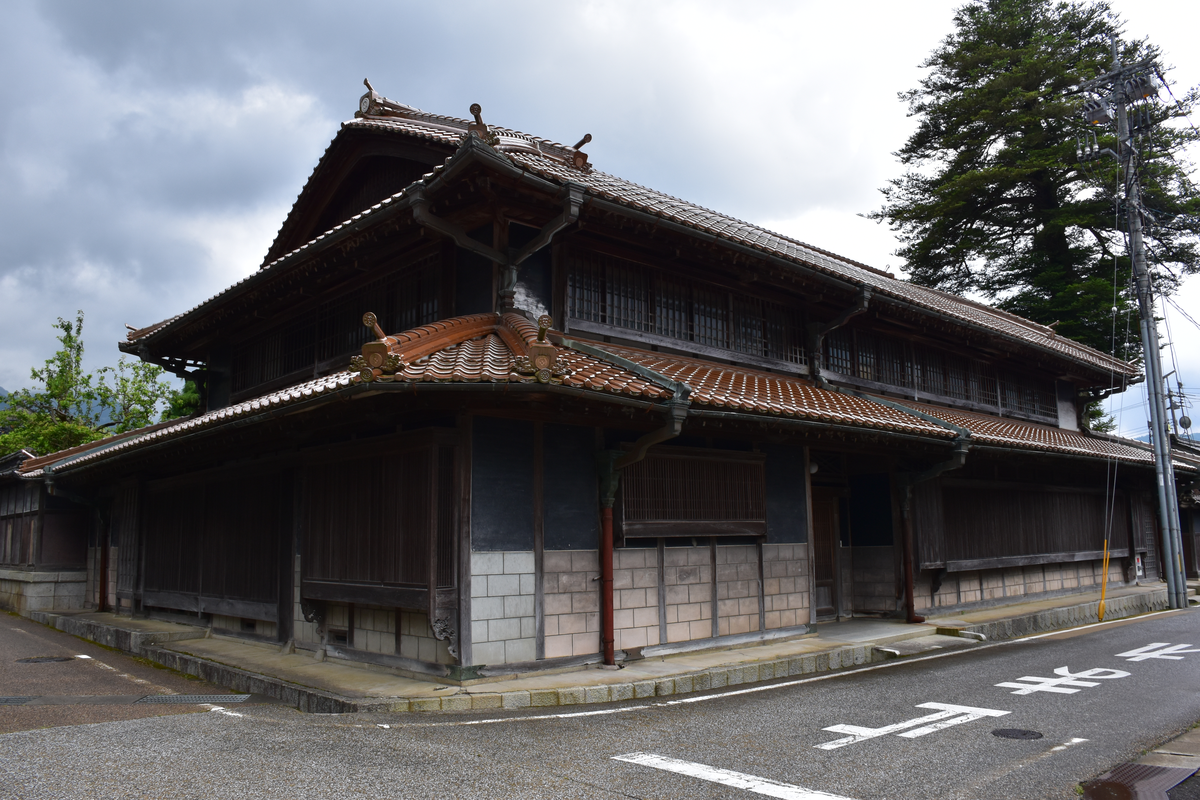
米原家住宅 国登録有形文化財(建造物) 登録:2014年12月19日 屋号を「木綿屋」と号す当家は、近世には大庄屋國米家(こくまいけ)の番頭を務め、近代には県政財界の重鎮となった。この度登録される当家の屋敷地は、智頭往来と備前往来の交差する角地に立地し、元は國米家の屋敷であったものを、明治38年以降に米原家の所有となったものである。 主屋は桁行十二間、梁間七間の大規模な二階建てで、屋根は入母屋造(いりもやづくり)桟瓦葺(さんがわらぶき)とする。近年の修理で屋根から下ろされた鬼瓦に、明治39年の銘が残ることから、この頃の建築と考えられる。外壁は黒漆喰塗とし、腰部分はモルタル洗出(あらいだし)で目地を切り、出格子(でごうし)を連続させる。良材を駆使して様々な趣きの座敷を多数有す、良質な近代和風建築である。 土蔵は土蔵造2階建で敷地に南奥に建つ。一階は二室、二階は一室とする。もとは、敷地内の別の場所に建っていたものを、昭和30年頃に現在地に移築した。建築年度は、戸の金物に國米家の「剣片喰(けんかたばみ)」の家紋があることから、当屋敷地が米原家所有となる以前の建物で、明治中期頃の建築と推定される。 上門は主屋の東、智頭往来に面してとりつく、三間一戸薬医門で、表側に控え柱を立て、そこから両脇へ塀を伸ばす。棟の輪違い積みに十文字をあしらう。天井には幅の広い隠岐スギを用いた豪壮な門である。大正前期の建築とかんがえられる。 下門は備前往来に面して開く脇門で、一間棟門の形式とする。釉薬の鬼瓦には米原家の家紋「菱木瓜(ひしもっこう)」を入れる。主屋と同様に明治39年頃の建築と考えられる。これら一連の建物からなる屋敷構えは、智頭宿の町並みの景観に大きく寄与している。 住所 鳥取県八頭郡智頭町大字智頭字町ノ内546
中町公民館(日本語のみ)
![]() 文化財(日本語のみ)
文化財(日本語のみ)
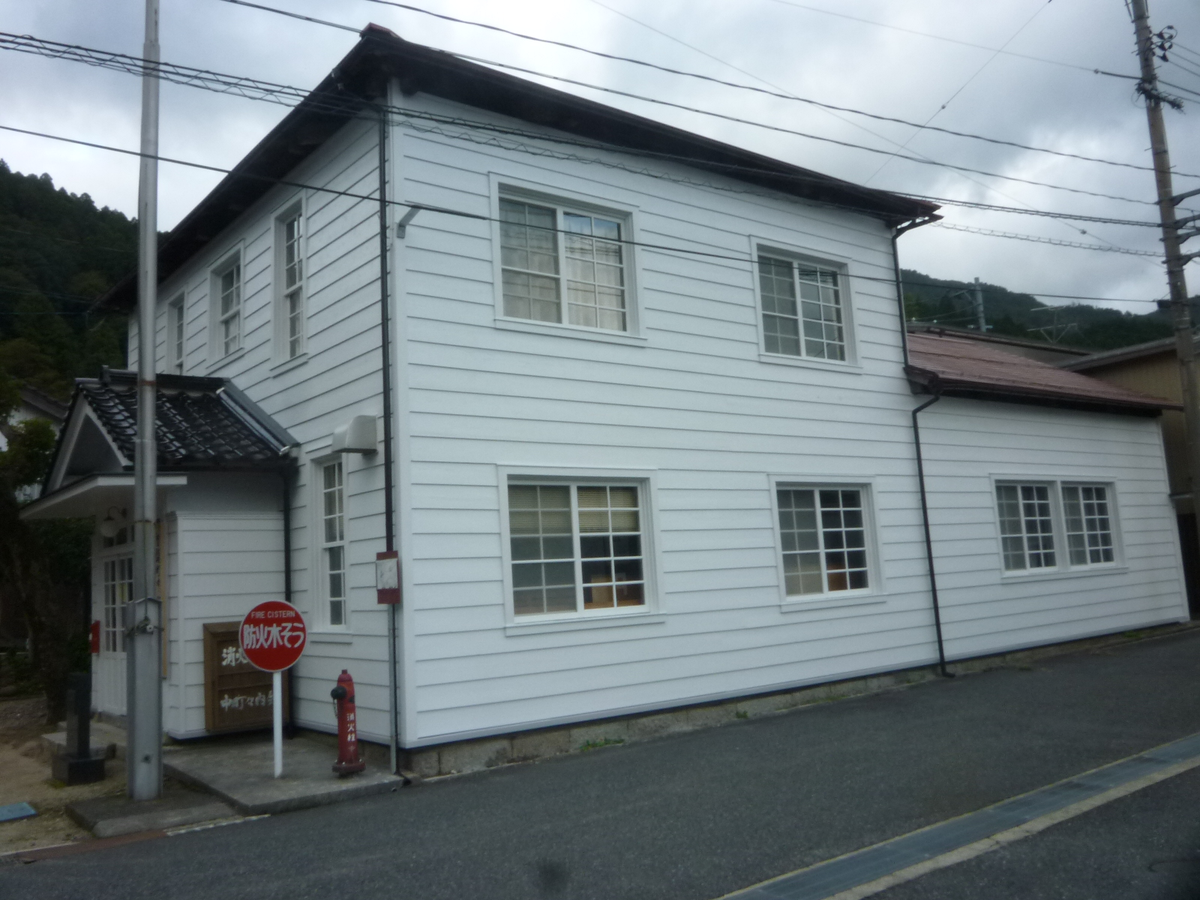
中町公民館 国登録有形文化財(建造物) 登録:2002年6月25日 中町公民館の沿革 江戸時代、参勤交代の制度にならって、鳥取藩池田侯の止宿地として智頭宿に御茶屋(御本陣)が設けられた。史料によると、建物は寛永15年ごろといわれ、およそ3000坪の敷地には壮大な建物と、智頭川に向かって御殿河原に続く池泉庭園、安政六年の建替には、敷地内に奉行所(番所)も置かれた。 明治6年9月、「故茶屋建物売り捌き帳」(旧塩屋出店文書)に払下げ金銭害付帳が残るところから、その後、お茶屋の建物は移築され、その一部の部材や士地が売却された。跡地内には明治7年から智頭尋常小学校が建設され、明治39年ごろには高等小学校も建設されたが、手狭なため44年ごろには現在の智頭小学校の場所へ移転していった。 大正始めごろ、残された建築は挽屋され、大正11年、1階は諏訪幼稚園が開設され、2階は智頭青年倶楽部が同居した。その建物が平成13年に復元され、中町公民館として受け継がれ、今日、地域の町づくりの拠点となっている。 建築物の初見 中町公民館はJR智頭駅の北北東約600m、国道53号の北側に位置し、北西の角地に西面して建つ。桁行14.6m、梁間7.3m、木造で西半を2階建、寄棟造、桟瓦葺とし、東半を平屋、東後方を切妻造とする。外壁を西洋下見板張りとする。 平面は、1階西端に玄関を付け、奥の東西に2部屋を設ける。西側を32畳の広さの板の問とし、天井を根太天井とし、四間スパンに大梁を渡す構造とする。東側を和室28畳間として、天井を竿縁天井とし、東側に床の間、物入を付属する。床の間の裏に物置を付ける。北側に突出して台所、便所を設け、板の間北西に階段への出入口を設ける。 2階は北西隅に段階を設け、西に八厚旦間を南北に並べ、南側八畳間東面に床の間及び押入を付属する。その裏東側に12畳の広さの板の間の物磁を設け、西而、北面に物入れを付ける。屋根は小屋組をキングポストトラス構造とする。 現在残る建物の建築の形式等をみると、玄関から広い板の間となり、また、その天井も根太天井で、この板の間を小割の部屋にした痕跡はなく、構造形式等から考えても学校建築の一部であったと考えられる。現建物は材の古さから推測して、高等等小学校が建てられた明治三九年ごろの建築と考えるのが妥当であろう。いずれにしても、正確な年代を知る資料がなく、明治後期の建物としておく。 中町公民館は、現在は中町町内会所有であるが、建設以降に学校から諏訪幼稚園と何度か用途を変更して現在に至る。その間に増改築があったと考えられるが、比較的当初の形式を残している。一階の和室や台所や便所には内装等に大きな変更があり、二階の物置も竿縁天井が残り、一時は和室に使われていたと考えられるが、その他は内部の変更は比較的小規模である。外観は平成22年の修理によって変更され、屋根は野地板から上を変更し、外壁の下見板もトタンに変えられていたものを復原した。正面の1、2階に残る上げ下げ窓は当初の形式を残している。 中町公民館は、大正期に小学校の一部を挽屋して造られ、その後何度か用途を変更して現在に至るものであるが、内部に小学校の形式を残し、主要な構造材をよく残し、外壁も復原されるなど、現在も活用される歴史的建造物として、価値がある。 住所 鳥取県八頭郡智頭町智頭554ー1
西河克己映画記念館(旧塩屋出店・洋館)(日本語のみ)
![]() 文化財(日本語のみ)
文化財(日本語のみ)
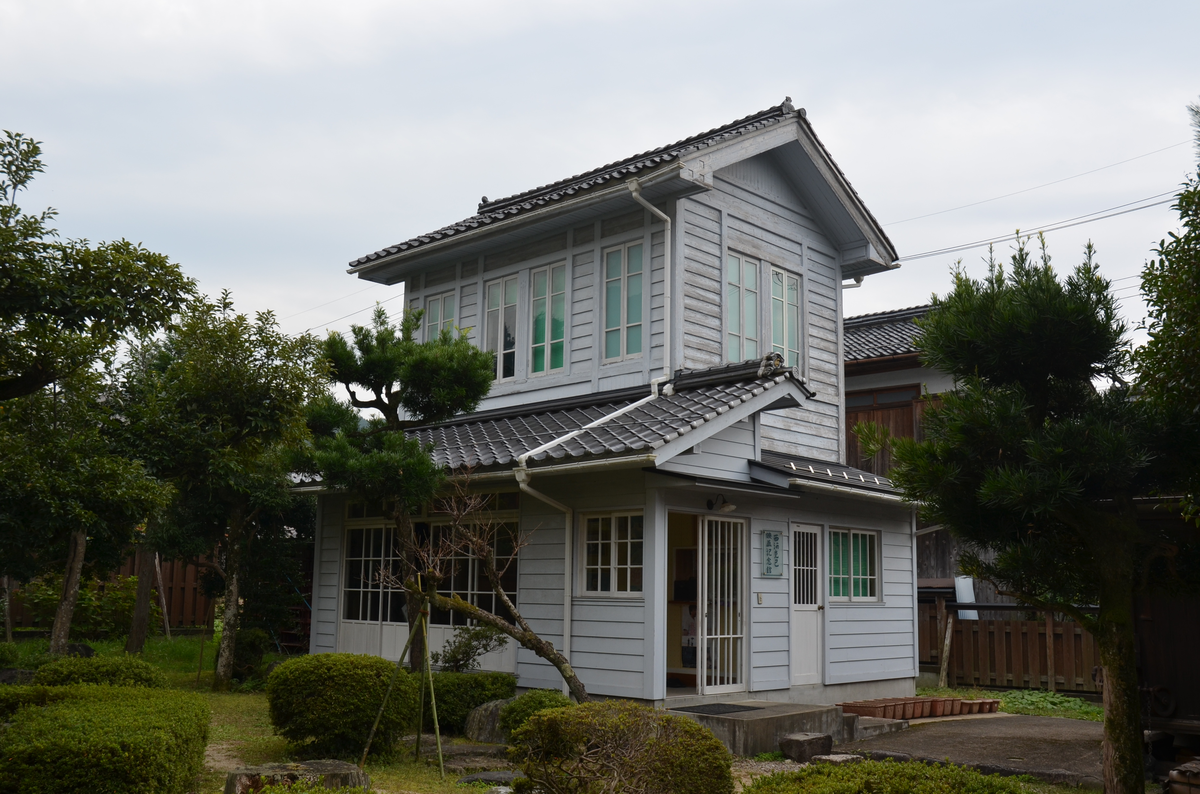
西河克己映画記念館(旧塩屋出店・洋館) 国登録有形文化財(建造物) 登録:2000年12月4日 洋館は旧塩屋出店の敷地後方、やや南側に建ち、主屋の便所等の突出部の東側に建つ。桁行三間、梁間二間半の規模とし、木造二階建、切妻造、桟瓦葺とする。いわゆる洋風建築の外観をもち、切石の礎石上に建ち、外壁は柱形をみせた下見板張りとする。現在は「西河克巳映画記念館」として使われている。 平面は、一階は北西隅に玄関を置き、その南側に管理室を設ける。東側一室を展示場とし、展示場北側面に掃き出しの戸口を付け、西側に二階への階段を置く。二階は一室とし、四周に両開き窓を付け、西側の階段の北側に物置を付ける。 屋根は二階を切妻造とし、軒裏に小天井を付ける。一階は北側に招造りの片流れ屋根を付ける。 建築年代は、昭和5年頃と伝えられ、旧塩屋出店の四代目の当主愛蔵が長男吉兵衛の病気療養のために建て、健康管理に配慮して天井を高く、採光のとれる洋風建築にしたと伝えられている。その吉兵衛も昭和10年に学校の場として開放されたと伝えられる。平成12年には、主として屋根や一階の下屋となる外壁の修理を行って、現在の映画記念館として使われるようになった。 旧塩屋出店洋館は、保存・活用の措置が智頭町によってとられ、智頭町の中でも数少ない洋風建築の―つであり、保存状態のよい洋風建築の歴史的建造物として価値がある。 住所 鳥取県八頭郡智頭町智頭550ー11
旧塩屋出店(主屋)(日本語のみ)
![]() 文化財(日本語のみ)
文化財(日本語のみ)
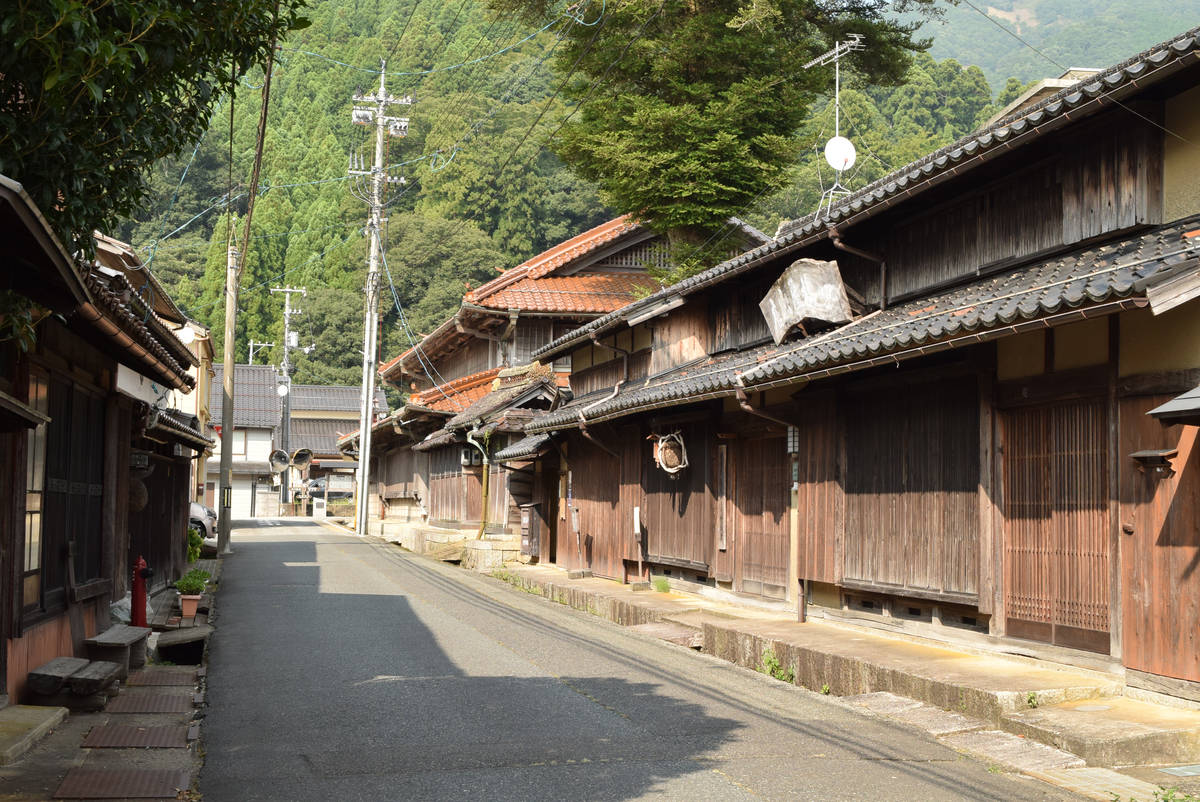
旧塩屋出店・主屋 国登録有形文化財(建造物) 登録:2000年12月4日 旧塩屋出店主屋はJR智頭駅の北北東約600m、国道53号の北側に位置し、桁行10間半、梁間4間の規模で、切妻造、瓦葺で、西面して建つ。前面道路に接して建つ町家の形式を持ち、前面の開口部には1、2階共に格子戸を付ける。東面南端に浴室、便所等を突出して建てる。主屋西面中央に玄関を構える。 平面は、1階の南側に土間部をとり、北側を床上部とし、北側及び東側に広縁をとる。床上部は北西端に床の間、違い棚付きの八畳間をとり、その東側に四畳の次の間をとる。それらの南側に、六畳間、四畳半間をとり、床上部南西隅に玄関土間を設け、その東側に三畳の玄関の間を続け、その東側に四畳半間を設ける。床上部南端の土間境に廊下を設け、南側に土間を続け、西側に二階への階段を設ける。玄関土間及び玄関の間を根太(ねだ)天井とし、その他の畳の間を竿縁(さおぶち)天井とする。土間は根太天井とし、土間南東隅を厨房とし、南東の突出部南側に便所、浴室を東西に並べる。浴室は折り上げ天井とし凝った造りを見せる。突出部北側に廊下を設け、身舎(もや)の広縁につなげる。 二階は西側道路に面して南北に六畳問、七骰半間をとり、共にやや上方に起(むく)った傾斜した天井とし、間に階段を置く。六畳間の東側に三畳間と四畳半間を南北に配する。三畳間東面に奥行きの浅い床の間を付ける。東側の二室は後の増築によるものである。建築年代は、棟札などの明確な記録が無く不明であるが、明治22年9月の智頭宿大火で焼失し、その後に建てられたと伝えられる。石谷家出店は、本石谷家六代目伝九郎の弟、吉兵衛が初代で、明治三年から三代日の吉平が智頭宿の庄屋村長を務め、雑貨商や宿屋、金融業を営み財を築き、明治18年12月に亡くなった。その後、四代目の愛蔵が家業を継いだと伝えられる。明治22年に家屋を焼失したとしても、その後すぐに主屋を建てなかったとは考えられず、大火直後に主屋を建てたと考えられ、建物形式や玄関、床の間の形式からも、明治中期の建築といえよう。 旧塩屋出店主屋は、桁行規模の大きな町家で、廊下をもつ形式や町家に玄関を付ける形式とするなど、近代の町家の特徴をみせ、智頭町の歴史的な町並みの形成に大きく寄与し、費重である。 住所 鳥取県八頭郡智頭町智頭545
下町公民館(日本語のみ)
![]() 文化財(日本語のみ)
文化財(日本語のみ)
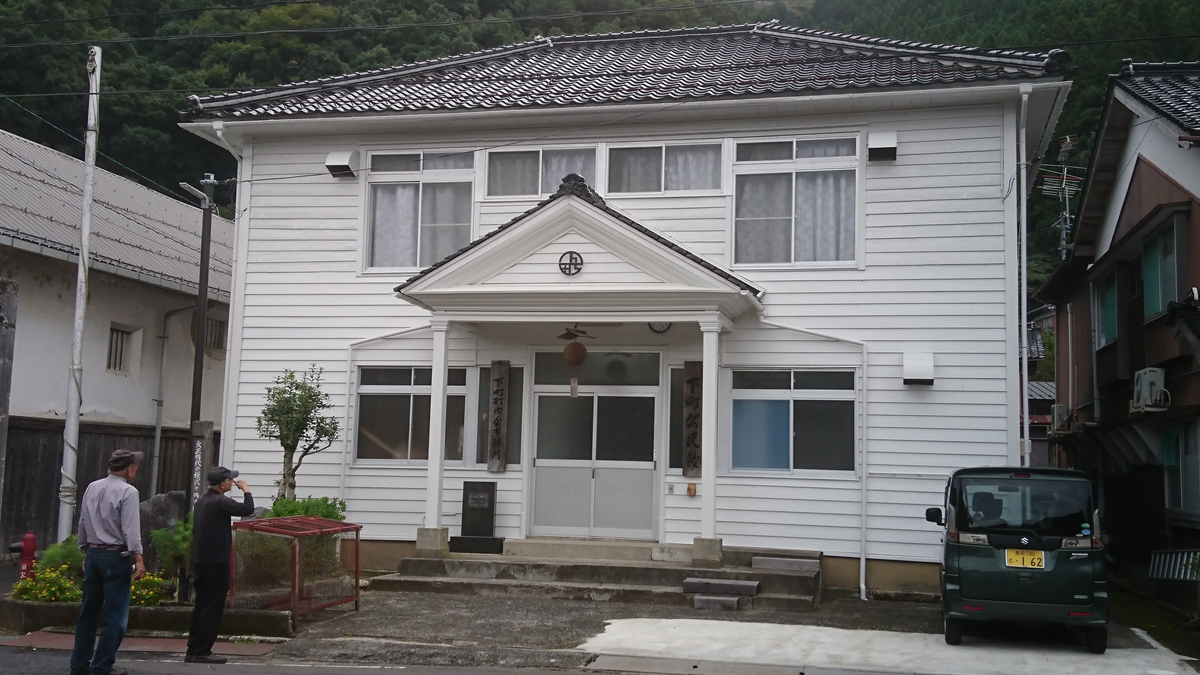
下町公民館 国登録有形文化財(建造物) 登録:2002年6月25日 下町公民館は、JR智頭駅の北北東約700m、国道53号の北側に位置し、千代川と平行に通る旧街道の北側に建つ、桁行10.9m、梁間7.3mの規模とし、木造二階建、寄棟造、桟瓦葺で、南面して建つ。洋風建築の形式をもち、正面に桟瓦葺でペディメント付きの玄関ポーチを付ける。基礎をコンクリート布基礎とし、側面に特徴のある鋳鉄製面格子を付けた床下換気口を開き、外壁を西洋下見板張りとし、白色ペンキ塗りで仕上げる。 平面は、1階は南側正面中央に玄関ポーチを設け、奥に土問の玄関を設け、玄関奥を24畳の広さの板の問のホールとし、その東側に南北に台所と和室を設ける。玄関西側を倉庫とし、北東隅に便所を突出して設ける。ホール北東に2階への階段を設ける。 2階は南側に約35畳の広さの畳の間を設け、北側東西に階段ホール、倉庫を設ける。屋根は小屋組をトラスとし、周囲の軒裏を小天井の形式とする。 建築年代は、棟札などの明確な記録が無く不明であるが、大正3年に約140m東の、上町の米原家の敷地に建設された旧役場を、現地に挽屋して智頭町役場として使ったとの伝聞があり、また、昭和6年の議会資料「庶務璽要害類綴」に「役場位置移転ノ事」とあり、この頃の移転とも考えられる。昭和20年には、河原町通りに役楊が移転したので、その後、昭和28年には智頭電報電話局が使用した。昭和58年に半解体修理が行われ、以後、下町公民館として使われている。 下町公民館は、大正期から昭和初期に智頭の役場として建設され、その後も公的な建物として町の発展に貢献し、当時の洋風の公共建築の外観をもち、現在も公民館として町民に親しまれ、智頭町の歴史的建造物として貴重である。 住所 鳥取県八頭郡智頭町智頭414
